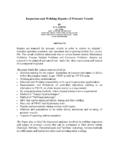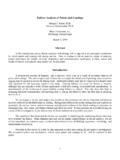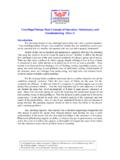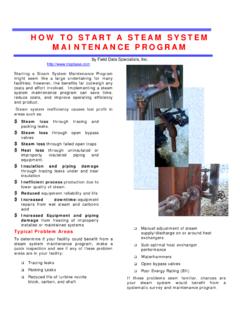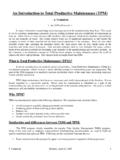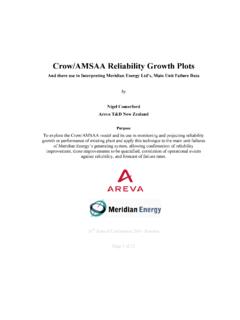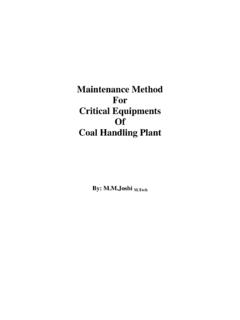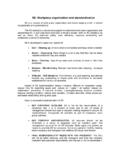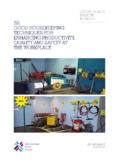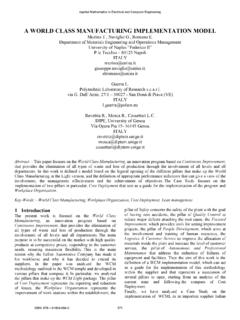Transcription of TPM OVERVIEW - plant-maintenance.com
1 OVERVIEWM anufacturing & Administrative of TPM Main manufacturing excellence approach of Toyota and other excellent Japanese companies since the 70 s. TPM is foundationfor JIT, FA, Poka Yoke, Lean Manufacturing, Zero Defects. TPM Reference Standard -JIPM(Japan Institute of Plant Maintenance) Comes from the best of Japanese Industrial Excellence and evolved from the heat of the continuing Energy Crisis and Globalization challenges to achieve More with OVERVIEW Of1. Autonomous Maintenance2. Equipment Improvement3. Planned Maintenance4. Quality Maintenance5. Office of AM StepsSteps 1,2,3 Improve the Equipment User -FriendlinessSteps 4,5,6 Improve Worker Know-how to maintain Equipment through Structured Specific 7 Flattened #Step GoalStandardsStep 1 Restoration=> 85% repair rateStep 2 Eliminate Sources of Contamination=>70% successful effortStep 3 Improve Equipment Accessibility=>70% successful effortStep 4 Initial Maintenance Standards> 50% sudden b/d reductionStep 5 General Inspection Skills> 90% sudden b/d reductionStep 6 Autonomous Inspection> 95% sudden b/d reductionStep 7 Organise and manage workplaceTBD by managementAM of Planned ZERO EQUIPMENT BREAKDOWNS by implementing systems of parts replacement before failure throughTBM and Autonomous Maintenance StandardsGeneral Inspection Stds.
2 +Annual Maintenance PlansEquipment Total Maintenance Maintenance Activities:o Support Autonomous Maintenance Activities by technical support, breakdown analysis and demarcation between Production & P-M Analysis for chronic Time Based Maintenance itemso Condition Based Maintenance Spares Mgtm & Maintenance Day of Plant EI TeamAchieve systematic breakthroughs in equipments 6 BIG LOSSES and establish Standards for Basic Machine Basic Machine Conditions are:1. Cleaning Lubrication Bolt-tightening 6 Big Losses (Focus is at the Bottleneck processes.)1. Breakdown Losses2. Speed Setup Defect Start-up or Yield Losses6. Minor Stoppages 1 LEVEL 2 LEVEL 3 LEVEL 4 Have chronic B/Ds B/d Repair time PM time. >20% deviation ofservice life range. Root-cause s of breakdownnot clear. Only spontaneousbreakdowns.
3 B/d Repair time = PM time. Within parts service lifespan. Root-causes of B/Ds areclear and addressed. Time-based component D/Trepair time < PM time B/d downtime < 1% Service life of components=> upper range of specs. Condition-based maintsystem Maint staff do only PM. AM do D/T repairs < at DT level. Clear improvementin MTBF Incomplete setupdocumentation. Setup times variation>30%. Complete set-updocumentation On-line and off-line setupsare defined. SetupTime variation < 15% Successful efforts to converton-line to off-line setups All adjustments are fullyclarified and standardized. Optimal set-ups under 10mins. 1st time set-up produce goodparts. No need to adjust anyfurther. No awareness/data. Data on frequency, locationof minor stoppages.
4 Root-causes of minorstoppages are clear andcountermeasures in place. Zero minor stoppages. Equipment specs not clear. No settings documented bydifferent packages/machine models & types. Root-causes are clear Settings documented bypackage / machine type. < 5% variation between sametype machines Countermeasures for root-causes of speed lossesimplemented. Revised settings with notes onquality and accuracy impact. < 2% speed loss. Operates at designed speed orabove. Zero Speed losses Nothing done aboutchronic losses. No results from previousactions Chronic defects arequantified by type, frequencyand volume. Root causes for problems areidentified and understood. Countermeasures implemented effective for early in-processdetection of defects. Q-components identified andeffects on quality are clear.
5 M-Q relationship established. Regular audit of Q-components Loss due to quality defects is< Defect &StartupLossesLEVEL 1 . Reduced 1/20th of current Of Equipment 6 Big & Chronic ProblemsWhy-WhyP-M problems with clear and assignable problems with clear causes & no effective Analysis & P-M Analysis Used with other data analysis or data collection tools. Emphasize on logical reasoning to fully understand the whole chain of cause-effects so as to devise holistic multiple solutions. All defects, breakdowns, accidents and work problems are result of an error by Man which is the Root Cause. Problems are traced to all the 4Ms Solution Sustained by linked to the TPM Maintenance:is activities to set equipment conditions,based on the basic concept of maintaining perfect equipment to maintain perfect quality of processed goods.
6 The machine conditions (Q-Components)are checked and measured in time-series to verify that measured values are within standard values to prevent defects. The transition of measured values is watched to predict possibilities of defectsoccurring and to take countermeasures Identify all the Q-components 2. Implement fool-proofing techniques toprevent man and materials-caused Eliminate all Chronic of Plant TPM-QMAchieve ZERO DEFECT by identifying all the upstream factors of Equipment causes of defectsand implementing fool-proofing techniques toeliminate man and materials-caused OFFICE TPM Is a structured 5S program using Why-Why Analysis as a problem-solving tool. Has similar Autonomous Maintenance 5 Steps Improves CRITICAL FUNCTIONS of Ware-house, Storage Place, administrative areas through work-flow studies. Areas contributing to OEE losses are selected for Kai zen 5S step-by-step - Cleaning & - Eliminate Stains, Mixed, - Improve Standardization & Control of - Self ManagementThoroughly restore & through Root Causes of Dirt, Mixing,Loss, damage and take 1 minute accessibility time for documents + parts.
7 Implement stock-management-at 1 a problem-free work flow in stock inventory, data Managing Work Teams.
